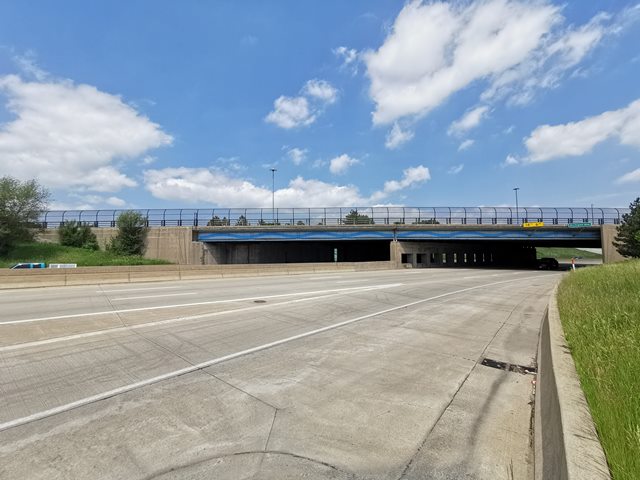We Recommend:
Bach Steel - Experts at historic truss bridge restoration.
BridgeHunter.com Phase 1 is released to the public! - Visit Now
US-12 Michigan Avenue I-94 Bridge

Primary Photographer(s): Nathan Holth
Bridge Documented: May 29, 2022
US-12 (Michigan Avenue) Over I-94 (Edsel Ford Freeway and Detroit Industrial Expressway)
Dearborn: Wayne County, Michigan: United States
1948 By Builder/Contractor: Darin and Armstrong, Inc of Detroit, Michigan and Engineer/Design: Hazelet and Erdal of Chicago, Illinois and Michigan State Highway Department
1996
119.0 Feet (36.3 Meters)
224.0 Feet (68.3 Meters)
90 Feet (27.43 Meters)
2 Main Span(s)
11140

View Information About HSR Ratings
Bridge Documentation
This bridge and interchange was found historic by the Michigan Historic Bridge Inventory for its significance as an early and important interchange in Michigan. The bridge retains good integrity except for the loss of original railing.
This page refers to the main bridge carrying US-12 over the mainline of I-94. However, this page also includes photos of three other bridges related to this interchange. One carries US-12 over the ramp from US-12 to Westbound I-94 is is located immediately west of the main bridge. Another carries the ramp from US-12 to Westbound I-94 over I-94. The other carries the ramp from US-12 to Eastbound I-94 over I-94.
View Archived National Bridge Inventory Report - Has Additional Details and Evaluation
View Historical Articles About This Bridge
Information and Findings From Michigan Historic Bridge InventoryNarrative Description The Detroit Industrial Expressway and the Edsel Ford
Expressway became models for freeway design throughout the country,
helping to stimulate the construction of the modern interstate system.
The U.S. Highway 12 Bridges qualify for the National Register as
representative examples of the structures designed for these innovative
highways. The bridges are also eligible under for their engineering
significance. Standing where the two expressways merge, the bridges
represent the successful solution to an intersection that was
challenging to design and construct. |
![]()
Photo Galleries and Videos: US-12 Michigan Avenue I-94 Bridge
Bridge Photo-Documentation
Original / Full Size PhotosA collection of overview and detail photos. This gallery offers photos in the highest available resolution and file size in a touch-friendly popup viewer.
Alternatively, Browse Without Using Viewer
![]()
Bridge Photo-Documentation
Mobile Optimized PhotosA collection of overview and detail photos. This gallery features data-friendly, fast-loading photos in a touch-friendly popup viewer.
Alternatively, Browse Without Using Viewer
![]()
Maps and Links: US-12 Michigan Avenue I-94 Bridge
Coordinates (Latitude, Longitude):
Search For Additional Bridge Listings:
Bridgehunter.com: View listed bridges within 0.5 miles (0.8 kilometers) of this bridge.
Bridgehunter.com: View listed bridges within 10 miles (16 kilometers) of this bridge.
Additional Maps:
Google Streetview (If Available)
GeoHack (Additional Links and Coordinates)
Apple Maps (Via DuckDuckGo Search)
Apple Maps (Apple devices only)
Android: Open Location In Your Map or GPS App
Flickr Gallery (Find Nearby Photos)
Wikimedia Commons (Find Nearby Photos)
Directions Via Sygic For Android
Directions Via Sygic For iOS and Android Dolphin Browser
USGS National Map (United States Only)
Historical USGS Topo Maps (United States Only)
Historic Aerials (United States Only)
CalTopo Maps (United States Only)

